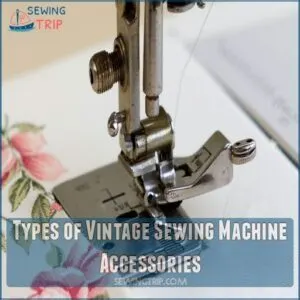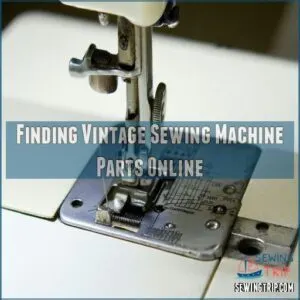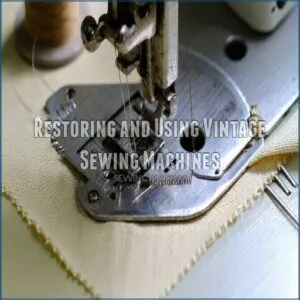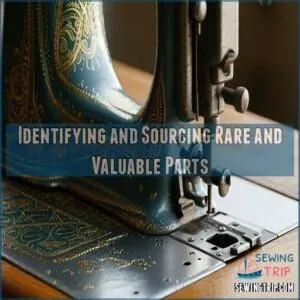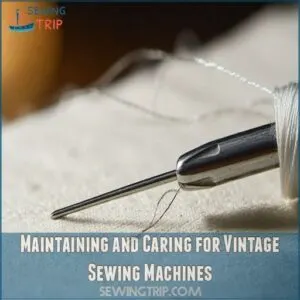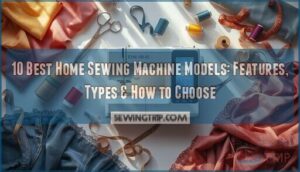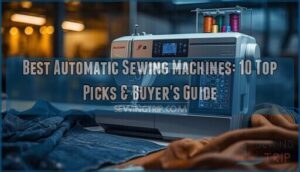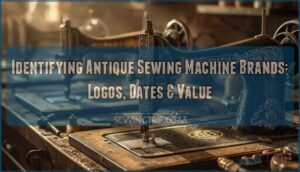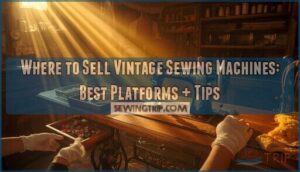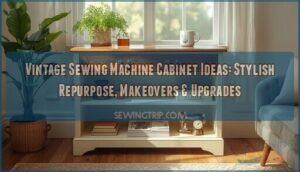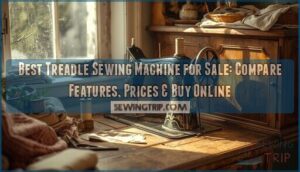This site is supported by our readers. We may earn a commission, at no cost to you, if you purchase through links.
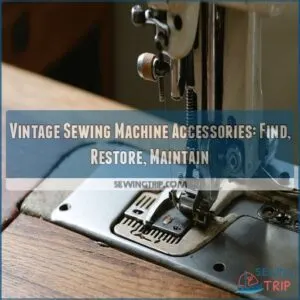
Each accessory—from basic sewing feet to specialized cording and zipper feet—holds the power to transform your creations.
Imagine finding a hemmer attachment that seamlessly elevates your grandmother’s old Singer to new creative heights.
You can track down these gems online, where retailers and forums can be your best friends.
Don’t forget to assess your machine’s condition first!
With the right tools, you’ll restore vintage glory but also gain a new sense of mastery.
Curious about rare parts and their historical tales? Stick around to discover more.
Table Of Contents
Key Takeaways
- You can elevate your vintage sewing projects with accessories like basic sewing feet, zig-zag attachments, and specialty feet, enhancing your machine’s functionality and versatility.
- There’s a wealth of resources online, including specialized retailers and forums, where you can track down and purchase vintage sewing machine parts and accessories.
- Restoring and maintaining vintage machines involves careful assessment, sourcing the right parts, and regular care like cleaning and lubrication to keep them running smoothly.
- Discovering rare and valuable parts can enrich your restoration projects, and expert appraisal can help determine the historical significance and market value of your antique sewing machine.
Types of Vintage Sewing Machine Accessories
Explore vintage sewing machine accessories where basic sewing feet and specialty attachments like zig-zag or hemmers expand your machine’s capabilities.
Each accessory offers specific functions that make sewing projects more efficient and varied.
Basic Sewing Feet and Attachments
Exploring basic sewing feet and attachments is like discovering your machine’s superpowers.
Common foot types such as standard presser, zipper, or cording feet perform unique tasks, from hemming to embellishing.
Essential attachments expand your machine’s abilities, offering versatility.
Check model specifics to see if feet are compatible, and practice foot care to maintain these nifty vintage sewing machine accessories effectively.
Low Shank Zig-Zag Attachments and Feet
Fitting low shank zig-zag attachments to your vintage sewing machine can open up a world of creativity.
They let you switch up stitching styles effortlessly.
You can also find various low shank zig-zag attachments online at Low Shank Zig-Zag Attachments.
Here are essentials:
- Installation Tips: Make sure it’s compatible.
- Types: Check vintage sewing machine feet options.
- Uses: Great for decorative stitches.
- Compatibility: Works with low shank machines.
Cording and Zipper Feet Options
Cording and zipper feet transform your sewing machine into a designer’s tool.
Whether attaching cords or zipping through fabric, these vintage feet are true masters of precision.
Consider these options:
| Cording Foot Types | Zipper Foot Styles |
|---|---|
| High Shank | Adjustable |
| Back-Clamp | Invisible |
| Vintage Brands | Side Attack |
| Compatibility | Narrow Edge |
Vintage sewing tools like these open new avenues for creativity.
Hemmers and Specialty Feet
While cording and zipper feet let creativity flow, hemmers and specialty feet fine-tune your vintage sewing.
Different hemmer types help with neat finishes, and knowing hemmer brands like Simanco brings precision.
Care for these vintage sewing tools is key.
When you learn the ropes of sewing machine attachments, you open up new possibilities with these timeless accessories.
Finding Vintage Sewing Machine Parts Online
You can easily find vintage sewing machine parts online using specialized retailers. Websites and online marketplaces offer a wide selection of parts often categorized by machine make and model.
Online Retailers Specializing in Vintage Parts
Browsing online for vintage sewing machine parts? Consider specialty retailers like A1 Sewing Machine Parts Inc. and Old Singer Shop, or websites dedicated to specific parts like vintage machine needles.
They offer a treasure trove of sewing machine accessories and antique sewing machine parts.
Check retailer reputation, part availability, and vintage part pricing before buying.
A good returns policy gives you the freedom to return if necessary.
Keep an eye on shipping terms.
Searching for Specific Parts by Make and Model
To tackle finding specific parts by make and model, embrace your detective skills.
Jot down your machine’s model number and any unique markings, such as the serial number that can help determine its age.
Consulting resources like Singer’s online database for Singer sewing machine models can be a great starting point.
Online resources can be your treasure map, especially for Singer models.
Websites offer vintage parts catalogs.
Focus on part identification for success.
This strategy works wonders, particularly with Singer sewing machine parts and accessories, including the iconic Featherweight.
Utilizing Online Marketplaces and Forums
Finding vintage sewing machine parts is like a treasure hunt.
Online marketplaces and vintage sewing machine forums offer endless possibilities.
Check seller reviews and explore online parts databases for rare finds.
You’ve got tips to uncover hidden gems, making you the captain of your collection.
Embrace these resources and enrich your sewing adventures with collectible sewing accessories and essential repair parts.
Contacting Manufacturers for Parts and Information
After exploring forums, reach out to manufacturers directly for vintage sewing machine parts.
They can offer:
- Part availability: Verify if they stock rare components.
- Warranty info: Check if any sold parts come with guarantees.
- Repair services: Inquire about repair possibilities.
- Historical data: Request information about your machine’s past.
This approach uncovers hidden gems and helps you successfully restore your machine.
Restoring and Using Vintage Sewing Machines
Restoring and using vintage sewing machines involves checking their condition and sourcing the right parts.
You bring an old machine back to life by ensuring each piece fits perfectly and functions smoothly.
Assessing The Condition of The Machine
Get a feel for your sewing machine’s story by checking its overall condition.
Inspect for rust and wear, noting any missing parts.
A simple functionality test—does it sew a straight line?
Use the table below to guide your evaluation:
| Aspect | Checkpoints |
|---|---|
| Rust & Wear | Look for corrosion |
| Missing Parts | Identify absences |
| Functionality Test | Try basic sewing |
This assessment is your first step in sewing machine restoration.
Determining The Feasibility of Restoration
Before diving into a vintage sewing machine restoration, carefully assess the project’s feasibility.
Consider the machine’s condition.
Evaluate the cost of parts.
Factor in your restoration skills.
Account for the time commitment.
Many vintage machines, with their metal construction, are built to last and can be a worthwhile investment due to their long-term durability benefits.
Parts availability impacts feasibility.
Is the restoration realistic given these factors?
A thorough assessment prevents costly mistakes.
Enjoy the process!
Sourcing Vintage Parts and Accessories
Looking for vintage sewing machines? Start by exploring online retailers that specialize in antique sources.
Join forums where enthusiasts share stories and parts.
Scout marketplaces for hidden treasures like vintage sewing machine parts and accessories.
Be sure to check machine history to uncover rare items.
Remember, restoring value lies in finding the right parts.
Utilizing Vintage Parts to Restore Functionality
You’ve found the perfect vintage sewing machine parts — now what?
Test that restored beauty’s functionality by using those authentic treasures.
Sure, restoration costs can be steep, but each stitch revives the charm.
Keep an eye on machine value and authenticity concerns.
From vintage sewing machine needles to antique tools, it’s all about balancing nostalgia with seamless functionality.
Identifying and Sourcing Rare and Valuable Parts
As a vintage sewing machine enthusiast, you know that finding rare and valuable parts can transform your restoration project.
Prized machines and understanding their historical significance to guide your search for unique accessories.
Identifying Desirable and Valuable Sewing Machines
Treasure hunting for vintage sewing machines is like a voyage back in time.
Look for rare models like the Singer Featherweight.
Recognizing historical significance can make all the difference.
Identifying valuable sewing machines involves checking unique features and craftsmanship.
Consider these gems for restoration or as cherished collectibles.
Seek professional appraisal to truly understand their worth.
Researching Market Value and Historical Significance
Understanding what makes a vintage sewing machine valuable is like discovering a story from the past.
Consider these aspects:
- Production Year: Early models often hold more worth.
- Condition: Pristine machines attract higher interest.
- Brand Reputation: Some names are more desirable.
- Unique Features: Special attachments or designs add appeal.
- Market Demand: Trends influence collector interest.
Finding Rare and Valuable Parts and Accessories
Ever unearthed a rare part for your vintage sewing machine?
Identifying rare parts can feel like a treasure hunt.
Begin by scouring online marketplaces and antique sewing machine shops.
Networking in vintage sewing machine forums can uncover hidden gems.
Keep an eye on auctions and estate sales where vintage sewing machine attachments surface, preserving your machine’s value and restoring functionality.
Seeking Professional Appraisal and Guidance
Want a fair price for your antique sewing machine? Get an appraisal.
Expert advice helps determine its value.
Consider restoration costs.
Parts identification impacts the antique sewing machine value.
Research market trends.
A vintage sewing machine appraisal offers insights.
Knowing the appraisal value helps if you’re selling your vintage sewing machine for sale.
Building an antique sewing machine collection requires careful assessment.
Vintage sewing machine restoration costs can be high.
Maintaining and Caring for Vintage Sewing Machines
To keep your vintage sewing machine running smoothly, regular cleaning and lubrication are essential. Proper storage and handling will help maintain its functionality and preserve its value over time.
Cleaning and Lubricating Vintage Machines
To keep your vintage sewing machine humming nicely, grab a soft cloth and a gentle brush for a cleaning spree.
Dust off the nooks and crannies.
Pick the right lubricant type; vintage sewing machine oil works wonders.
Apply oil sparingly, following a regular maintenance schedule.
Regular care helps you sew smoothly, preserving your machine’s charm and functionality effortlessly.
Storing and Handling Vintage Machines
Keep your vintage sewing machine in tip-top shape with proper storage and handling.
Use dust covers to protect it from dirt.
A sturdy vintage sewing machine case prevents bumps during transport.
Always handle with care, using vintage sewing machine tools to manage adjustments.
Regularly apply vintage sewing machine oil to keep parts running smoothly, and make sure your machine stays in working order.
Troubleshooting Common Issues and Repairs
Got storage sorted? Now let’s tackle troubleshooting those vintage machines.
Identifying common problems is key: loose threads, misaligned sewing machine needles, or stuck bobbins.
If your machine is using vintage sewing bobbins, make sure they’re the correct size for your machine.
Repairing broken parts often just needs a steady hand and the right sewing machine tools.
Sometimes, sourcing parts locally helps.
Keep a toolkit ready to maintain your machine’s charm and functionality.
Happy sewing machine repair!
Preserving The Value and Functionality of Vintage Machines
You’ve tackled the quirks and repairs, now it’s about preserving your vintage machine’s charm and functionality.
A little elbow grease goes a long way.
Regular cleaning and careful lubrication are key.
Store the machine in a dry spot to avoid rust.
Safeguard those antique machine parts with gentle handling.
Remember, every stitch tells a story, so keep it spinning smoothly.
Frequently Asked Questions (FAQs)
Where can I Buy Vintage sewing machine parts & accessories?
Explore the blend of past and present by visiting specialized online retailers like A1 Sewing Machine Parts Inc., Sewing Machine Parts, and Old Singer Shop.
Buy vintage sewing machine parts and accessories suited to your nostalgic needs.
Where can I find parts for a vintage Singer sewing machine?
You can find vintage Singer sewing machine parts at online retailers like A1 Sewing Machine Parts Inc. and Old Singer Shop.
Online retailers are a good place to start your search.
You can also check local antique shops and flea markets for specific model parts and accessories.
Are antique sewing machine parts easy to find?
Finding parts for an antique sewing machine isn’t too tough.
Many online retailers specialize in these components.
Search by make, model, and part number.
You can also try antique shops or sewing machine forums.
What are vintage sewing machine parts made of?
Vintage sewing machine parts are mostly made of metal, with common materials including steel, brass, and iron.
This durability made them long-lasting.
Plastic might be used in newer vintage models for specific components like buttons.
Where can I find sewing machine parts?
Online retailers specialize in antique sewing machine parts.
Check out websites like Sewing Machine Parts or the Old Singer Shop.
Local antique stores or flea markets are also great places to look.
You can also contact manufacturers directly.
How do I find parts for my antique sewing machine?
Identify your machine’s make, model, and serial number.
Use resources like manuals and online shops.
Search specialized sites such as A1 Sewing Machine Parts or Old Singer Shop for the specific parts you need.
How old does a sewing machine have to be to be considered an antique?
You’re right; it can be confusing.
Typically, a sewing machine becomes an antique when it’s over 100 years old.
This age gives it historical significance, capturing a bygone era’s craftsmanship and design charm.
Is it worth keeping an old sewing machine?
Keeping an old sewing machine can be rewarding.
They often boast superior craftsmanship and unique features.
Restoring one can offer a sense of accomplishment, nostalgia, and value, especially if it becomes a cherished family heirloom.
What should I do with my old sewing machine?
Around 84% of Americans own a sewing machine they no longer use.
It’s a win-win for creativity and utility!
Transform yours into a DIY project, donate it to a local school, or sell it to vintage enthusiasts.
Is there a market for old sewing machines?
Absolutely, there’s a thriving market for old sewing machines, especially among collectors and hobbyists.
Vintage models often hold historical value and charm, making them desirable for restoration projects or display.
Adding nostalgic appeal to any space.
How do I choose the right foot pedal?
Choosing the right foot pedal for your sewing machine isn’t scary.
First, check compatibility with your machine’s brand and model.
Consider the pedal’s responsiveness, comfort underfoot, and ease of control.
A sturdy build guarantees lasting performance.
Are vintage sewing machines beginner-friendly?
Vintage sewing machines aren’t always beginner-friendly. They often need more care. Repairing them can be tricky. Modern machines are generally easier to use.
Can I use modern needles in vintage machines?
Yes, you can use modern needles in vintage sewing machines, but check compatibility first.
Many machines take standard needles, but double-check your model’s requirements to avoid issues.
It’s a small detail with big impact.
Whats the best way to store vintage machines?
To store vintage machines, find a dry space with stable temperature.
Use snug, breathable covers to prevent dust and rust.
Keep them on sturdy surfaces.
Occasionally rotate and oil parts to maintain smooth operation and prevent deterioration.
Are there risks with antique machine power cords?
Imagine plugging in a relic from a bygone era.
Old power cords can be brittle, frayed, or unsafely wired, risking electrical faults or fires.
It’s wise to inspect or replace them before use.
Conclusion
Uncovering the past often feels like unearthing buried treasure, especially when talking about vintage sewing machine accessories.
By understanding various accessories—from basic feet to rare specialty attachments—you breathe life back into your machines.
Online resources and expert guidance make finding and restoring these gems a breeze.
With a bit of care, you preserve the function and the legacy of these machines for future generations.
Jump in and stitch your history back together.

